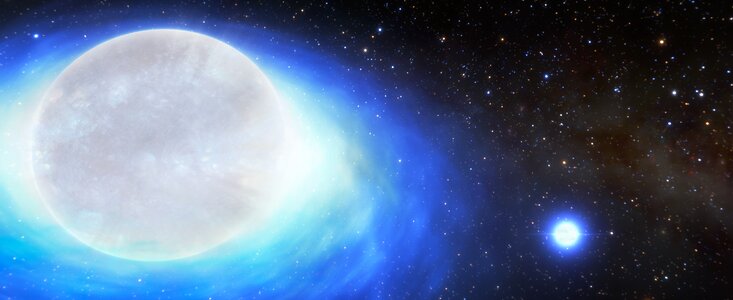[ad_1]
“A Billion-to-One Odds: A Closer Look at the Impending Kilonova Explosion of One in Ten Star Systems”
The incredibly rare star system has been described as a “one in 10 billion” find. (NOIRlab)
Discovered for the first time, an incredibly rare star system will eventually rupture itself in a “kilonova” – a massive explosion producing heavy metals like gold.
Gold and other heavy elements like platinum are formed in kilonova explosions, where two neutron stars merge.
Neutron stars are the burned-out cores of dead stars and are so dense that a handful of their material would weigh as much as Mount Everest.
These systems are so phenomenally rare that only about 10 are thought to exist in our entire Milky Way.
Astronomers discovered the unusual system CPD-29 2176, located about 11,400 light-years from Earth.
Continue reading: There may once have been life on the moon
Observations with the SMARTS 1.5-meter telescope allowed them to infer the orbital properties and types of stars that make up this system – a neutron star created by an ultra-stripping supernova and a tightly orbiting massive star, who is about to become an ultra-stripped Supernova herself.
An ultra-stripped supernova is the end-of-life explosion of a massive star that has had much of its outer atmosphere stripped away by a companion star.
This class of supernova lacks the explosive power of a traditional supernova, which would otherwise “eject” a nearby companion star from the system.
Lead author Noel D. Richardson of Embry-Riddle Aeronautical University in the US said: “The current neutron star would have to form without ejecting its companion from the system.
“An ultra-stripped supernova is the best explanation for why these companion stars are in such a tight orbit.
“To someday create a kilonova, the other star would also need to explode as an ultra-stripped supernova, allowing the two neutron stars to eventually collide and merge.”
Continue reading: Hubble discovers something very strange flying through the solar system
The discovery and study of kilonova progenitor systems like this one not only represents the discovery of an incredibly rare cosmic curiosity, but may also help astronomers unravel the mystery of how kilonovae form.
This will shed light on the origins of the heaviest elements in the universe, such as gold and platinum.
“For quite some time, astronomers have speculated about the exact conditions that could ultimately lead to a kilonova,” said NOIRLab astronomer and co-author Andre-Nicolas Chene.
“These new results show that, in at least some cases, two sibling neutron stars can merge if one of them formed without a classic supernova explosion.”
Although this system has the right material to eventually form a kilonova, it will be up to future astronomers to study this event.
It will be at least a million years before the massive star ends its life as a titanic supernova explosion, leaving behind a second neutron star.
This new stellar remnant and the preexisting neutron star must then gradually coalesce in a cosmic ballet, slowly losing their orbital energy as gravitational radiation.
When they eventually merge, the resulting kilonova blast will create much more powerful gravitational waves, leaving behind a large amount of heavy elements, including silver and gold.
Richardson said: “This system shows that some neutron stars are formed with just a small supernova kick.
“By understanding the growing population of systems like CPD-29 2176, we will gain insight into how quiescent some stellar deaths can be and whether these stars can die without traditional supernovae.”
Observe: Scientists observe a supernova that pushed particles to cosmic boundaries
[ad_2]
Don’t miss interesting posts on Famousbio










